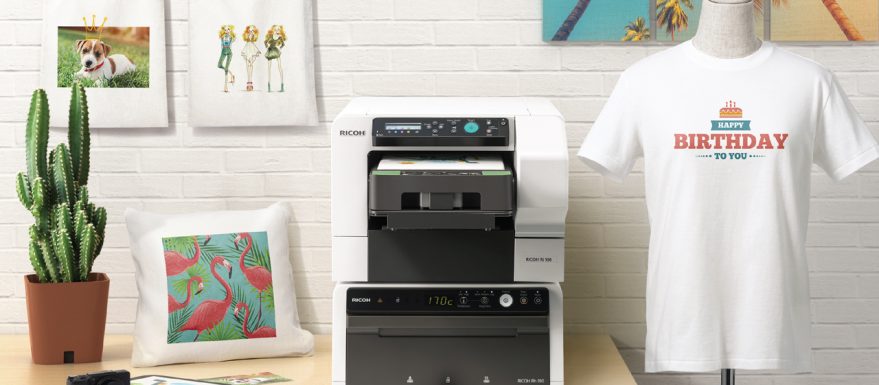From mass-produced to mass-personalised

With the advent of social media, namely Instagram, and a focus on the unique and customised, we are seeing a shift from mass-produced to mass-personalised. This goes for both fashion and for business collateral like branded reusable bags, branded napkins, branded t-shirts and accessories. Opportunities to get your brand and message out there, for longer than a single-use second, are endless.
As a result, direct to garment (DTG) printing technology has evolved. Forget iron-ons and screen printing, and the limitations and inconsistencies that clunky technology delivered. Recently, Ricoh released its new DTG printer range with the Ri 100 entry level printer and the Ri 3000 and Ri 6000 (for more serious users). However, the Ri 100’s entry-level price and quality print, is what has printing companies and businesses signing cheques without blinking at the
price tag.
For less than $10,000, you can purchase a Ricoh Ri 100 printer. (Keep in mind that previously, a start-up model DTG printer was around $20,000 for the printer and a heat press.) The Ri 100 is compact in size, easy to operate, delivers a high-quality output and rapid return on investment. An average print costs less than $1.50 ex GST for ink, plus the cost of your shirt/bag/tea towel/cushions covers/aprons/whatever. Obviously, the more you use it, the more rapid your return. And if you are printing to sell, the ROI is even more rapid again.
Ricoh’s base level DTG printer (starting around $8,000) is a light-coloured-garment-only printer, which means it will print on almost anything cotton (from 50% cotton blends up to 100% cotton) and does not include a white ink or toner. (Printing on dark garments uses much more ink than printing on light coloured garments, and is therefore costlier per print.) It is still stitches above competitors. As yet, no other company has come near Ricoh’s price.
Add to that, it prints at 1200 x 1200 dpi for a detailed print with smooth gradations, supports wireless printing, and includes automatic maintenance features.
The uses for this type of DTG printer product are only increasing. Print business owners know the demand for custom print shirts and branded collateral is on the rise, and not every customer wants garment print runs of 100, or to wait six weeks for delivery from China. Ricoh’s Ri 100 prints in colour, in 80 seconds or less when in ‘speed mode’ and 150 seconds or less in ‘fine mode’. This gives you power to deliver short-turn-arounds, and small print runs, at quality, and affordably, which can really expand the scope of your business.
“Not every customer wants garment print runs of 100, or to wait six weeks for delivery from China. Ricoh’s Ri 100 prints in colour in 80 seconds or less.”
Small business owners and start-up e-commerce merchants selling custom items like t-shirts, cushion covers, aprons, and the like, are increasing, and once order volumes reach stable sales, it can become more economical to manage apparel printing internally. The Ri 100 is a game-changer for those business owners. They can now afford to managing printing internally, on demand. When doing your numbers, keep in mind that, as with any printer, printer redundancy is real. This entry level DTG will give you between 3.5 to five years. You will also get an average of 200 prints, maximum of 1000 prints, per month out of your Ricoh Ri 100.
So how do the numbers stack up? Let’s say a blank t-shirt costs you $5, you use $1.50 of ink per shirt, and you sell each shirt for $20. Take away your other operating costs (sale administration, electricity, etc.) and you are making $10+ profit per shirt. You only need to sell around 23 shirts per month to cover the cost of your machine ($10,000 over 3.5 years).
Comparing DTG printing to its alternatives of screen printing and sublimation printing, DTG is attractive for many printers. Direct printing allows maximum detail and colours in the design, is suited to printing photographs, can be easily customised and is minimal upfront investment. Meanwhile, screen printing is cost effective for large print runs (because the expense is based on the set-up cost) but is not easily customisable, can only print simple designs, and is a large upfront investment. The third alternative, sublimation printing, is the process of printing onto a special sheet of paper then transferring to fabric by heating until the ink disintegrates into the fabric.
Advancements in technology are always thrilling, particularly when it results in savings to the bottom line, and greater creativity and freedom within your business. If you are interested in finding out more about the Ricoh Ri 100, get in touch with Delta, your workplace technology partner.






